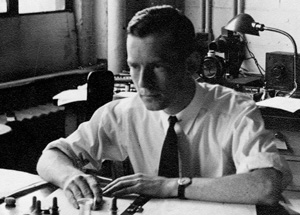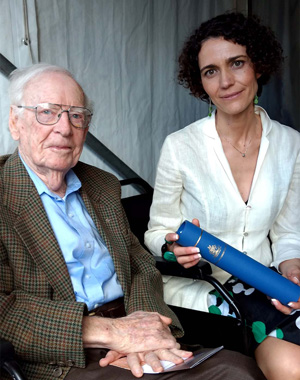

At the ripe old age of 97, the late Dr Max Day AO FAA was still contributing to science, helping to uncover the mystery behind the scribbles on gum trees, considered by many to be an icon of the Australian bush.
Dr Day, who died on Monday 31 July at the age of 101, spent a lifetime championing the study of insects (entomology), conservation, the environment, and forestry. His research also played a major role in controlling Australia’s rabbit problem.
Dr Day was born in Sydney in 1915. He studied science at the University of Sydney and was awarded the university medal in 1937, graduating with a bachelor’s degree in science.
An ecologist and entomologist who collaborated with Australian greats of both disciplines, Dr Day was a member of the CSIRO Executive for eleven years, during which he was responsible for all the CSIRO Divisions dealing with plant and animal sciences.
Dr Day was the first Chairman of the Australian Institute of Marine Science, and coordinated the report that led to the establishment of the Institute near Townsville, North Queensland. He was the founding Head of CSIRO’s Division of Forest Research for five years which led to Australia’s international recognition for its contribution to forest research.
Dr Day also worked extensively with the CSIRO insect collection. His passion for studying insects is perhaps best described in an interview he gave with Academy Fellow Professor Robyn Williams AM FAA in 2015.
“Insects, there are so many of them. It’s a field which goes on forever.”
He applied his work on insect hormones and insect digestion to a critical study of how animal and plant viruses are spread by insects. Dr Day worked with Academy Fellow and virologist Professor Frank Fenner AC FAA FRS to control Australia's wild rabbit population using the virus that causes myxomatosis, a project he described as the most satisfying achievement of his career.
“The government introduced myxo into Australia in 1950 to control rabbits as they had become a serious problem across the country,” he told his Academy colleagues in 2015.
‘Frank, who I had never previously met, approached me at a meeting here in Canberra and said: ‘We believe myxomatosis might be mosquito-borne. Would you be interested in taking on the mosquito side of it while I do the biology?’, and so for the next five years Frank and I worked on the transmission of the myxo virus.”
Elected to the Australian Academy of Science in 1956, just two years after the Academy was founded, Dr Day was the Academy’s longest serving Fellow and one of Australia’s oldest scientists. He told his Academy colleagues that he still clearly recalls watching the then Prime Minister Sir Robert Menzies lay the foundation stone for what is now known as the Shine Dome in 1958.
Dr Day was one of the founding members of the Australian Conservation Foundation, a strong supporter of national parks, and was made an Officer of the Order of Australia (AO) in 1977.
In 2012 aged 97, Dr Day co-authored a paper with Dr Marianne Horak and others about the Ogmograptis scribbly gum moth, describing eleven new species of the moth. Even more remarkable was the recognition that different species made different scribbles.
The author of the Snugglepot and Cuddlepie books, May Gibbs, made scribbles a feature of the gumnut babies’ world, and the great Australian poet Judith Wright cemented their place in literary culture with her 1955 poem Scribbly-Gum.
Dr Day and his co-authors found that the patterns are made by the moth's various developmental stages, and change according to the stage.
“The eggs are laid on the bark and the caterpillar burrows in and then just goes around making scribbles,” Dr Day said in his 2015 interview with Professor Williams.
In May this year, Dr Day presented two early-career researchers, Mr Nicholas Leseberg and Dr Marta Yebra, with inaugural Max Day Environmental Science Fellowships, established in his honour.
Through sponsoring this award Dr Day acknowledged the support that he himself received as a young researcher to travel overseas to gain his PhD at Harvard.
© 2025 Australian Academy of Science